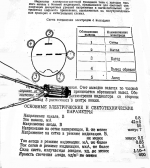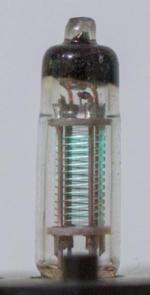
ИВ-15iv-15
|
|
|
Hits: 3454 Replies: 1
iv-15 : Compared to the DM160
|
||||||||||||||||||||||||||||||||||
|
Michael Watterson
01.Dec.11 |
1
The IV-15 is often sold as a DM160 equivalent. It's about 1/2 the price or less and is a similar kind of tube. But it's not the same, only similar. Diameter about 6.5mm and length about 24.5mm, the glow is a bit broader and shorter. On overall volume the DM160 is slightly smaller, but about 3mm longer including tip. The IV-15 filament volts is slightly lower (0.6V to 0.9V) with slightly higher current of about 35mA @ 0.6V At 20V HT the Anode currents for varied g is
Note: [1] If there is a series resistor on 0V side of filament to allow 1.2V operation, or part of the 120 Ohms for 5V, then the 0V on grid completely extinguishes lamp. The brightness is usable at 10V HT (400uA) and 35mA @ 0.6V filament with g= 5V Summary Anode Current vs HT for fixed g= 5V, Vf = 0.6V & 35mA
Assuming I understand the Russian Data sheet:
For the measurements above I had
With a different wiring arrangement it's possible to have a -5V on filament and drive from PNP Germanium Transistors. The filament runs then off 0V and -5V with suitable pair of resistors in the filament connections. Likely the same is true with variations for the DM160. At +12V and -5V supplies the indicator would be quite usable (perhaps 33 Ohms on one filament connection and 68 Ohms on the other). While LEDs were discovered in about 1906 and 1924, they were commercialised from about 1962. The DM160 was released in 1959 and release date of the IV-15 is unknown. The advantages the DM160 and IV15 have though is "built in" triode, so can be an amplifier and quite high input impedance. Power consumption for equal brightness is though much lower* for the VFD even including filament which is why the multiplexed VFD seven segment displays in pocket calculators saw usage till the mid 1970s. Larger LED displays only used for desktop application as LCD became standard for pocket calculators and watches. Today the VFD technology pioneered in the DM160 is still used in POS, set-boxes, kitchen appliances and cars. Though the Anode design of modern VFD is more related to the DM70 (DM71) than DM160. The DM160 and iv15 use "coil" of wire like a grid for the Anode. Modern VFD are actually more like a DM70 / DM71, except the filament is at a constant distance (on DM70 it's closest at the dot) and the keyhole grid plate replaced by a grill/mesh type grid even closer to Anode, hence modern VFD the grid is about -1V to -5V compared to filament for off and equal to HT / Anode (9V static, 22V multiplexed) when on. The modern VFD is thus still a triode but with more like DM70 construction and iv15 operation. If you run a DM70 of 10V HT you will find the bar doesn't change in length with grid (which like iv15 must be positive) but brightness only as Vg increases from 0V to 10V HT. Just like a VFD. See Also Vintage Indicators, DM70 , DM71 and DM160 (* High Efficiency LEDs are much later, after LCD is common) |
|||||||||||||||||||||||||||||||||
|
Michael Watterson
05.Dec.11 |
2
Comparative size of typical B7G tube, DM70/DM71, RCA type Sub-miniature, rod Pentode, DM160 and iv15 |
|||||||||||||||||||||||||||||||||
End of forum contributions about this tube
| Data Compliance | More Information |



